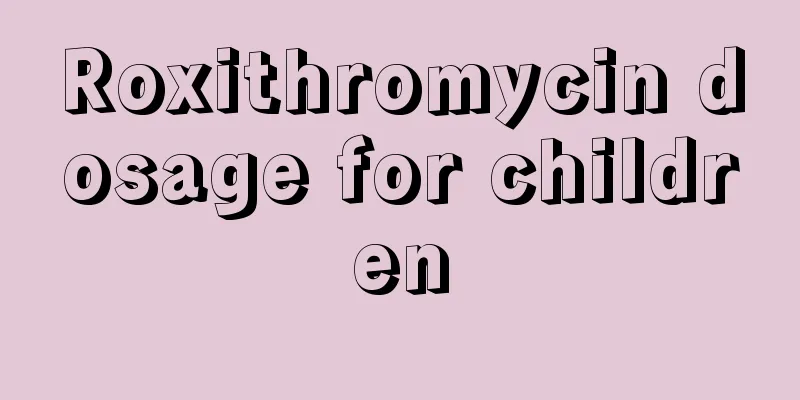Roxithromycin dosage for children

|
Roxithromycin is a very common drug in life, and it can be used at any age, including children. However, if children use it, it is best to use it under the guidance of a doctor. If children take it, the dosage is generally taken twice a day, and the best amount for each dose is 2.5-5.0 mg/kg. It can be taken before or after meals. Roxithromycin dosage for children: 2.5-5.0 mg/kg per day. Take in 2 doses. When this product is used in combination with theophylline or carbamazepine, the dosage does not need to be adjusted. There is cross-resistance between this product and erythromycin. Take 1 hour before or 4 hours after meals. Taking the drug after eating will reduce drug absorption because roxithromycin is a fat-soluble drug. It should be mixed with boiled water or taken with water. It should not be taken with tea or other beverages. Precautions when taking roxithromycin 1. Cross-allergy: When a patient is allergic to one macrolide drug, he may also be allergic to other macrolide drugs. 2. Use with caution: (1) Patients with impaired liver function; (2) Pregnant or lactating women. 3. When taking the drug for a long time, attention should be paid to monitoring liver function; when roxithromycin is used together with theophylline, theophylline blood concentration should be monitored. Adverse reactions of roxithromycin The adverse reactions of roxithromycin are mild and the incidence is low (the overall incidence is about 4%). 1. Gastrointestinal symptoms such as abdominal pain, diarrhea, nausea, and vomiting are more common, but the incidence is significantly lower than that of erythromycin. 2. Occasionally, mild allergic reactions such as rash, urticaria, itching, drug fever, etc. may occur. 3. A small number of patients may occasionally experience abnormal liver function after taking the medicine. 4. A small number of patients occasionally experience symptoms such as headache and dizziness after taking the medicine. Roxithromycin is a new generation of macrolide antibiotics and a semi-synthetic 14-membered macrolide drug. Its mechanism of action is the same as that of erythromycin, which is mainly to bind to the bacterial 50S ribosomal subunit, inhibit the synthesis of bacterial proteins by blocking transpeptidation and mRNA translocation, thereby exerting an antibacterial effect. Its characteristic is that it can quickly enter macrophages, pneumocytes, alveoli, and polymorphonuclear leukocytes. The antibacterial spectrum of roxithromycin is similar to that of erythromycin. Its in vitro antibacterial effect is similar to that of erythromycin, and its in vivo antibacterial effect is 1 to 4 times stronger than that of erythromycin. Roxithromycin is slightly less effective than erythromycin against Gram-positive bacteria, but more effective than erythromycin against Legionella pneumophila. Its antimicrobial effect against Chlamydia pneumoniae, Mycoplasma pneumoniae, and Ureaplasma urealyticum is similar to or slightly stronger than that of erythromycin. Roxithromycin has strong antibacterial activity against Staphylococcus aureus (except MRSA), Streptococcus (including A, B, C streptococci and Streptococcus pneumoniae, but excluding G type and enterococci), Corynebacterium, Listeria, Moraxella catarrhalis (catarrhal coccus), Legionella, etc.; it also has certain effects on anaerobic bacteria such as oral Bacteroides, black-producing Bacteroides, Peptococcus, Peptostreptococcus, Propionibacterium acnes, as well as Toxoplasma gondii, Chlamydia, Mycoplasma, Ureaplasma urealyticum, Treponema pallidum, etc.; it has weaker effects on Helicobacter, gonococcus, meningococcus, Bordetella pertussis, etc. Roxithromycin can inhibit most Gram-positive bacteria, and its antibacterial activity against common pathogens of respiratory tract and skin infections, such as Staphylococcus aureus, Staphylococcus epidermidis, Pneumococcus, Streptococcus pyogenes, Haemophilus influenzae, Mycoplasma pneumoniae and Legionella, is similar to that of erythromycin. It is effective against urogenital tract infections caused by Chlamydia trachomatis and Ureaplasma urealyticum, and against Treponema pallidum. |
<<: Can children take roxithromycin?
>>: Children with rhinitis and runny nose
Recommend
Why does my baby keep sneezing recently?
Sneezing is a very common problem in life. Becaus...
What to do if children have tooth decay pain
Tooth decay pain is quite common in children. In ...
What to do if a little girl has too much sweat
Little girls love beauty very much. Many parents ...
Can babies drink grapefruit tea?
Grapefruit tea is a drink that is deeply loved by...
What's the matter with the small granules on the child's back?
Children in their early childhood are very prone ...
My baby's hand is swollen because of something biting him.
Summer is the season with the most mosquitoes. Ba...
Treatment for persistent fever in infants
In our lives, it may often happen that babies hav...
What is the reason for the child's back pain
If a child has back pain, parents must pay attent...
What to do if the BCG abscess bursts
Some babies may have a needle port left when they...
Frequent urination in children
Frequent urination is very common. Many people ur...
When should babies take zinc supplements? When is the best time for babies to take zinc supplements?
Calcium, iron, zinc, selenium and vitamins are al...
9-year-old child shaking hands and feet while sleeping?
If a 9-year-old baby's hands and feet tremble...
How to take care of a child who suddenly has stomach pain
As children grow up day by day, some bad habits w...
What medicine should children take for iron deficiency?
Iron is an essential trace element for the growth...
What are the side effects of Xiyanping injection on babies?
Xiyanping injection is a traditional Chinese medi...









